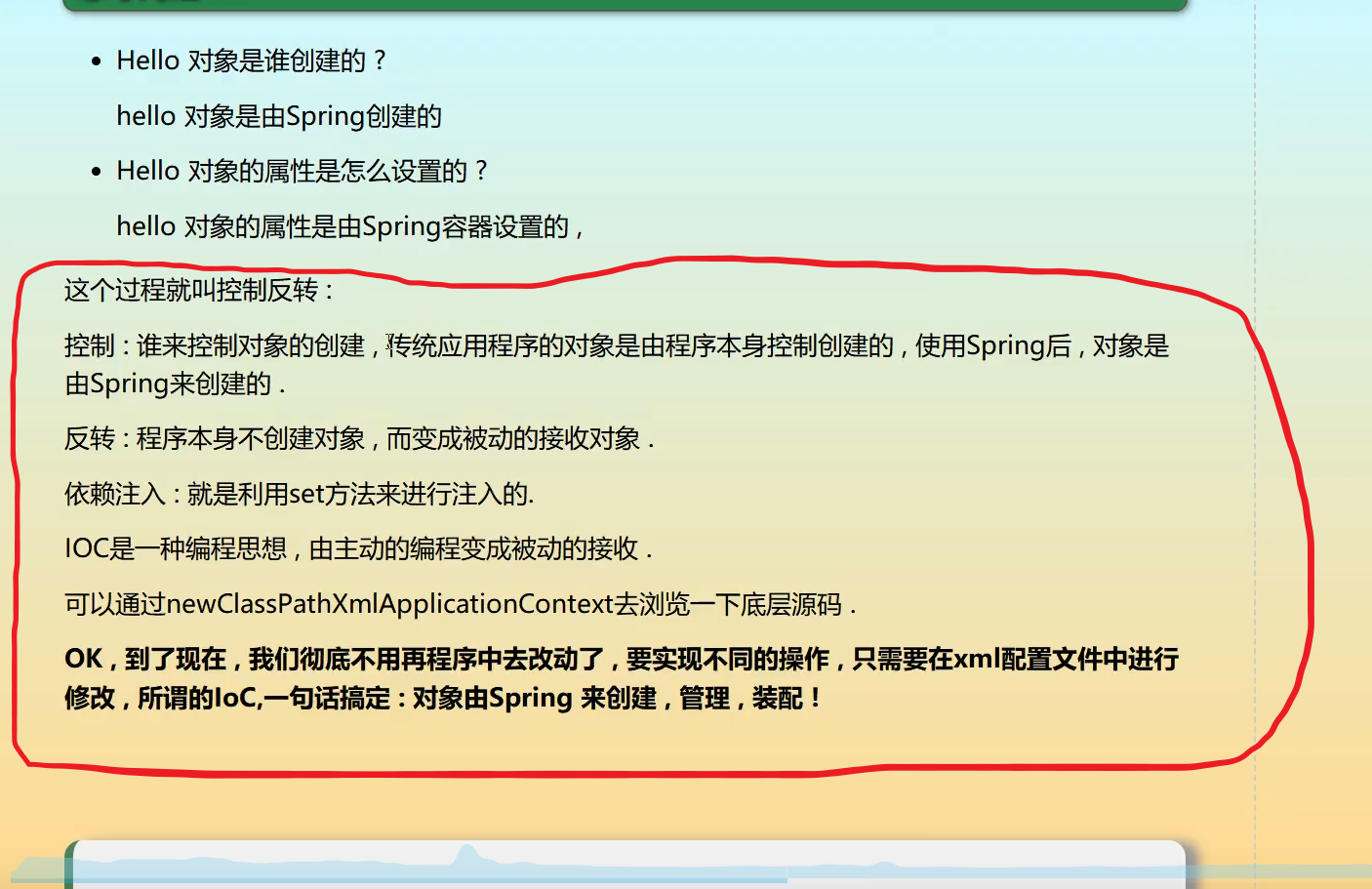1.写一个helloSpring程序
导入依赖
<dependencies><dependency><groupId>org.springframework</groupId><artifactId>spring-webmvc</artifactId><version>5.3.5</version></dependency>ganfbian//使用测试导入junit<dependency><groupId>junit</groupId><artifactId>junit</artifactId><version>4.12</version></dependency><dependency><groupId>org.springframework</groupId><artifactId>spring-context</artifactId><version>5.3.5</version></dependency></dependencies>
创建实体类
package com.sy.pojo;public class Hello {private String str;public String getStr() {return str;}public void setStr(String str) {this.str = str;}@Overridepublic String toString() {return "Hello{" +"str='" + str + '\'' +'}';}}
编写 Spring文件
<?xml version="1.0" encoding="UTF-8"?>
<beans xmlns="http://www.springframework.org/schema/beans"
xmlns:xsi="http://www.w3.org/2001/XMLSchema-instance"
xsi:schemaLocation="http://www.springframework.org/schema/beans
http://www.springframework.org/schema/beans/spring-beans.xsd">
<bean id="hello" class="com.sy.pojo.Hello">
<property name="str" value="Spring"/>
</bean>
</beans>
使用Spring中创建对象,在Spring中这些都称为Bean
类型 变量名 = new 类型();
Hello hello = new Hello();
id = 变量名
class = new 的对象;
property相当于给对象中的属性设置一个值
bean就是java对象 , 由Spring创建和管理
测试
import com.sy.pojo.Hello;
import org.junit.Test;
import org.springframework.context.support.ClassPathXmlApplicationContext;
public class test {
@Test
public void Text(){
//获取上下文对象
//解析beans.xml文件 , 生成管理相应的Bean对象
ClassPathXmlApplicationContext context = new ClassPathXmlApplicationContext("beans.xml");
//对象现在都在Spring中管理了,我们使用时,直接去里面取出就可
Hello hello = (Hello) context.getBean("hello");
hello.toString();
System.out.println(hello.toString());
}
}
//getBean : 参数即为spring配置文件中bean的id .
2.控制反转原理
3.修改案例一
修改beans.xml文件
<bean id="mysqlImpl" class="com.sy.dao.UserDaoMysqlImpl"/>
<bean id="UserServiceImpl" class="com.sy.service.UserServiceImpl">
<!--ref:引用容器中创建好的对象
value:具体的值-->
<property name="userDao" ref="oracleImpl"></property>
</bean>
测试
public static void main(String[] args) {
//获取ApplicationConext; 拿到Spring的容器
ClassPathXmlApplicationContext context = new ClassPathXmlApplicationContext("beans.xml");
UserServiceImpl userServiceImpl = (UserServiceImpl) context.getBean("UserServiceImpl");
userServiceImpl.getUser();
}
OK , 到了现在 , 我们彻底不用再程序中去改动了 , 要实现不同的操作 , 只需要在xml配置文件中进行修改 , 所谓的IoC,一句话搞定 : 对象由Spring 来创建 , 管理 , 装配 !
4.IOC创建对象方式
无参方法构造
实体类
package com.sy.pojo;
import java.util.Objects;
public class User {
private String name;
public User() {
System.out.println("User()被创建了");
}
public String getName() {
return name;
}
public void setName(String name) {
this.name = name;
}
public void show(){
System.out.println("name="+name);
}
}
beans.xml
<bean id="user" class="com.sy.pojo.User">
<property name="name" value="嘻嘻"/>
</bean>
测试
public static void main(String[] args) {
//获取ApplicationConext; 拿到Spring的容器
ApplicationContext context = new ClassPathXmlApplicationContext("beans.xml");
User user = (User) context.getBean("user");
user.show();
}
用debug断点测试,可以发现在调用show方法之前,User对象已经通过无参构造初始化了!
有参
有三种方法
<!-- 第一种:下标赋值-->
<!-- <bean id="user" class="com.sy.pojo.User">
<constructor-arg index="0" value="逢坂"/>
</bean>-->
<!--类型赋值,同类型有两个以上时不建议使用-->
<!--<bean id="user" class="com.sy.pojo.User">
<constructor-arg type="java.lang.String" value="大河"/>
</bean>-->
<!--直接通过参数名赋值-->
<bean id="user" class="com.sy.pojo.User">
<constructor-arg name="name" value="逢坂大河"/>
</bean>
User类:
public class User {
private String name;
public String getName() {
return name;
}
public void setName(String name) {
this.name = name;
}
public User(String name) {
this.name = name;
}
public void show(){
System.out.println("name="+name);
}
}
5.Spring配置
alias别名
<alias name="user" alias="laohu"/>
Bean的配置
<bean id="wife" class="com.sy.pojo.Wife" name="LaoPo,sama queen">
<property name="name" value="食蜂操祈"/>
</bean>
name的用法远比alias好用,中间用标点和空格等标识符就可以隔开创建多个别名
import
<import resource="beans.xml"/>
在总的applicationContext.xml中通过输入import导入其他xml,使用时直接引用applicationContext.xml就可。适用于团队合作的项目中。


